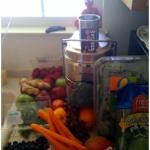USDA Certified Organic
- 2 Comments
- Posted By : Ritu
- On : February 25, 2010
- In : Foods
Over the last few years "Organic" has evolved to be the new buzz word, but what does it really mean and how can you tell if you are really eating organic? The USDA National Organic Program (NOP) provides the following (lengthy) description for organic:
Organic food is produced by farmers who emphasize the use of renewable resources and the conservation of soil and water to enhance environmental quality for future generations. Organic meat, poultry, eggs, and dairy products come from animals that are given no antibiotics or growth hormones. Organic food is produced without using most conventional pesticides; fertilizers made with synthetic ingredients or sewage sludge; bioengineering; or ionizing radiation. Before a product can be labeled "organic," a Government-approved certifier inspects the farm where the food is grown to make sure the farmer is following all the rules necessary to meet USDA organic standards. Companies that handle or process organic food before it gets to your local supermarket or restaurant must be certified, too.
The seal in the picture above is used to represent "organic" but with some fine print. Here is what you need to know.
On single Ingredient foods such as fruits, veggies, and even meats, milk, eggs, and sometimes cheese, look for a sticker similar to the one pictured above. This means it follows the guidelines above.
For multi ingredient foods, the USDA has identified three categories of Organic. This is important to know and will be helpful when looking at labels.
-
100% Organic: Made with 100% organic ingredients
-
Organic: Made with at least 95% organic ingredients
-
Made With Organic Ingredients: Made with a minimum of 70% organic ingredients with strict restrictions on the remaining 30% including no GMOs (genetically modified organisms)
Products with less than 70% organic ingredients may list organically produced ingredients on the side panel of the package, but may not make any organic claims on the front of the package.
Note that having a certified sticker is voluntary and many small farmers do not go through the process of becoming certified. If you are shopping at farmers markets it is your responsibility to ask the farmer how the food was grown to be sure of its level of being "organic". Shopping organic is a personal choice, however do the research and read labels prior to purchasing. Find out where the farm is that producing your food and what their process is. Many packages claim some degree of "organic" so be aware of the categories mentioned above. "Organic" regulations is an ongoing controversy, one which I imagine will continue to grow. If you are interested in getting more involved visit http://www.organicconsumers.org/ .
**The information in this article was adopted from www.organic.org
Nutritionize
Ritu










Here is some more info that was posted on my fb in regards to organic:
Somethings to keep in Mind when figuring out what it means to be USDA certified- they kinda stepped into the business when it needed to grow as a sector- a heavy capitalist thought process that at times takes away the essence of what it means to be “organic”.
The first one is a blog on the USDA which makes you think…
The second one is from a company that gives the straight up thoughts on loopholes that waterdown the usda symbol…… See More
Truly food for thought!!
http://blog.beliefnet.com/crunchycon/2009/07/cant-trust-the-usda-organic-la.html
http://www.edenfoods.com/articles/view.php?articles_id=78
I just saw this brief article on Yahoo about organic foods: http://shine.yahoo.com/event/makeover/12-foods-that-are-worth-the-organic-splurge-706366/